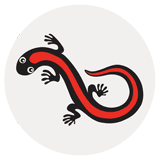The Salmonberry: a sign of spring and much more
July 8, 2015 | Aisha Balint
Every year, we look forward to seeing the signs of spring appear, often in the plants among us. One of the daintiest of these signs is the arrival of the small pink salmonberry flower (Rubus spectabilis). These little flowers will eventually develop into delicious berries that can be found until late July or so. Salmonberry is one of the first edible berries to emerge on our coast each year.
Salmonberry can be found along the coastline of British Columbia, with the overall range extending from Northern California up to Southern Alaska. This plant thrives in areas with moist soils and access to sunlight. Luckily, Tofino is no stranger to high precipitation levels, so these plants can be readily found along our roadsides, streams, and in open forests. Dense second growth forests rarely–if ever–contain salmonberry plants as not enough light reaches the forest floor. Once established, salmonberry shrubs can grow up to 4m high, and can form dense thickets or be found in stand-alone patches.
This broadleaf plant plays an important role in the early stages of the salmon lifecycle as a source of shade for streams, thus providing safe habitat for young salmon. However, this role is not the source of the plant’s name. Rather, the name comes from the appearance of the berries, which (most likely due to their colourful hues) resemble clumped salmon roe (eggs).
The berries range from pink to orange to red in colour, and can vary in taste depending on the plant. Some can be quite tart, while others can be deliciously sweet. Like the colouring, the local reviews of this berry cover a spectrum of possibilities from “filmy and tasteless” to “SO GOOD! They are my favorite!” It might be best to give these berries a couple of tries before deciding for yourself.
In addition to the easy-to-spot berries, this plant can also be easily identified by its foliage. This plant is deciduous, however, so both leaves and berries are absent in the winter months. When the leaves return, they grow in the same pattern as a raspberry plant: two lateral leaflets frame a larger terminal one, forming a trio. The stems are rounded, brown, often woody, and adorned with small thorns (so watch your hands and wrists if you go berry picking!).
Salmonberry, which has been used traditionally by the Nuu-chah-nulth, continues to be an important wild food source throughout the region. Unlike the salal berry, the salmonberry was never dried and stored for later use due to the high water content of each berry. They were only a seasonal treat. Other parts of the plant can also be harvested for medicinal purposes; Salmonberry leaves have been used in a tea that induces relaxation and sleepiness, and as a poultice to ease the pain of burns and cuts. Leaves are only medicinal when fresh or completely dried. They are mildly toxic if not harvested in the right conditions!
In addition to human uses, salmonberry is an important source of food and habitat for a variety of other animals. For example, the rufous hummingbird (Selasphorus rufus) is known to love the flowers of salmonberry. When the flowers arrive, we are sure to start seeing these hummingbirds again too. This hummingbird species enjoys the nectar of the flowers as well as the ideal nesting habitat. Other animals such as black bears, raccoons, and many bird species enjoy these colourful berries during their season, so please harvest in moderation to ensure that there is enough for all.
As summer winds to a close the berries that were spared will fall to the ground and offer seeds for new plants to grow. Eventually, the plant will shed it’s leaves, and be bare throughout the winter until, finally, the little pink flowers appear once again.



